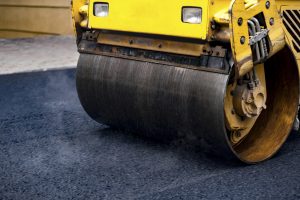Reimagine Your Area: Hot Mix Asphalt Paving for Angled Parking Lot Projects
Reimagine Your Area: Hot Mix Asphalt Paving for Angled Parking Lot Projects
Blog Article
Unlocking the Tricks of Warm Mix Asphalt Modern Technology
Discovering the depths of warm mix asphalt technology uncovers a world where accurate formulations and careful processes merge to shape our roads and facilities. The fusion of binders, fillers, and accumulations isn't just a construction task however a calculated orchestration of durability and performance.
Relevance of Hot Mix Asphalt
Warm Mix Asphalt plays a vital function in modern-day framework development as a result of its toughness and cost-effectiveness. As one of the most commonly used leading material for roads, freeways, and parking area, Warm Mix Asphalt provides a series of advantages that contribute to its significance in building tasks. One key benefit is its capability to hold up against rush hour loads and harsh weather conditions, offering a lasting and dependable surface area for transport networks. In Addition, Warm Mix Asphalt is economical in both initial building and lasting upkeep, making it a recommended choice for numerous framework jobs.
The longevity of Warm Mix Asphalt originates from its make-up, that includes accumulations, binder, and filler materials that are meticulously selected and mixed to satisfy certain efficiency demands. This exact mix causes a strong and adaptable sidewalk that can sustain regular usage without substantial damage. Hot Mix Asphalt is 100% recyclable, additional improving its sustainability and environmental benefits. On the whole, the importance of Warm Mix Asphalt in facilities advancement can not be downplayed, as it proceeds to be a keystone of modern building and construction practices.
Elements of Asphalt Mixes
The make-up of asphalt blends includes very carefully chosen accumulations, binder, and filler materials that are vital for achieving particular performance demands. Accumulations are the key part of asphalt blends, giving stamina and security. These accumulations can be natural, such as gravel or crushed stone, or synthetic, like recycled products from old sidewalks. The binder, typically asphalt or asphalt concrete, holds the accumulations with each other and offers adaptability and sturdiness to the mix. The option of the binder is critical as it straight influences the mix's performance in different climate condition. Fillers, such as hydrated lime or Rose city cement, are made use of to boost the mix's workability and aging resistance. Angled Parking.
The combination and proportion of these elements play a substantial duty in identifying the high quality and efficiency of the asphalt mix. Designers meticulously design the mix to satisfy particular demands, thinking about factors like traffic volume, climate conditions, and pavement life expectancy. Correct choice and harmonizing of accumulations, binder, and fillers are necessary for producing long lasting, durable asphalt sidewalks.
Mixing and Manufacturing Techniques

When the aggregates are chosen, the binder, often asphalt concrete, is contributed to bind the materials with each other. The binder's high quality and amount significantly affect the mix's strength, resistance, and versatility to ecological elements. Furthermore, fillers like moisturized lime or Portland cement may be integrated to boost details attributes of the asphalt mix, such as its workability or moisture resistance.
During production, the accumulations and binder are warmed, normally between 250-325 ° F(121-163 ° C ), to promote mixing and make sure proper finishing of the accumulations. The blending process must be extensive to achieve a homogeneous blend that advertises the preferred performance attributes of the asphalt. Numerous methods, such as batch blending or drum mixing, are utilized to accomplish regular and high-quality asphalt blends for building tasks.
Aspects Impacting Asphalt Efficiency
Variables influencing asphalt performance incorporate a series of variables that affect the longevity, longevity, and total quality of asphalt pavements. One essential aspect is the top quality of products made use of in the asphalt mix. The kind and source of accumulations, the binder quality, and the websites ingredients all play a considerable More Help role in identifying the efficiency of the asphalt pavement. The rank of aggregates is crucial as it impacts the mix's workability, security, and resistance to rutting and breaking.

Style considerations, such as sidewalk density and water drainage, are important in ensuring the long-term efficiency of the asphalt pavement. By very carefully considering these contractors, factors and engineers can enhance asphalt efficiency and improve the solution life of sidewalks.
Lasting Practices in Asphalt Modern Technology
:max_bytes(150000):strip_icc()/asphalt-worker-134249388-58cdf96f5f9b581d723f2f33.jpg)
WMA allows for the manufacturing and placement of asphalt mixes at reduced temperatures contrasted to conventional hot-mix asphalt, resulting in decreased power intake and greenhouse gas exhausts. The usage of permeable asphalt blends can help alleviate stormwater runoff problems by enabling water to penetrate through the pavement and right into the ground, advertising all-natural water purification and recharge procedures.
Final Thought
In final thought, hot mix asphalt innovation plays a crucial function in modern-day facilities growth because of its longevity and cost-effectiveness. By carefully balancing parts, utilizing correct blending methods, and thinking about numerous elements, designers can produce top notch asphalt blends that endure rush hour loads and harsh weather conditions. Welcoming lasting methods, such as using recycled products and warm-mix innovations, better enhances the ecological kindness of asphalt modern technology.
Blending and production strategies in hot mix asphalt modern technology entail the specific combination and handling of accumulations, binder, and fillers to create a high-performance and sturdy Check This Out asphalt mix.Variables affecting asphalt performance include a variety of variables that impact the durability, durability, and overall top quality of asphalt sidewalks. Sustainable techniques in asphalt technology incorporate numerous efforts aimed at lowering the ecological influence of asphalt production and paving procedures. By integrating reclaimed asphalt sidewalk (RAP) and recycled asphalt tiles (RAS) right into brand-new asphalt blends, the market can significantly minimize the consumption of raw materials and energy, while additionally lowering landfill waste.
WMA allows for the manufacturing and positioning of asphalt blends at reduced temperature levels contrasted to conventional hot-mix asphalt, resulting in reduced power intake and greenhouse gas emissions.
Report this page